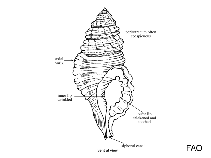|
Family Ranellidae - triton shells
|
Order |
: |
|||
Class |
: |
Gastropoda |
||
No. of Genera in Ref. |
: |
|||
No. of Species in Ref. |
: |
|||
Environment |
: |
Fresh : No |
Brackish : No |
Marine : Yes |
||
Aquarium |
: |
|||
First Fossil Record |
: |
|||
Remark |
: |
Shell ovate to fusiform, thick and solid, with a raised spire and strong sculpture composed of nodules, spiral ribs and axial varices. Periostracum frequently well developed and fibrous to hairy. Aperture with a short to long siphonal cana; anteriorly. Outer lip prominently thickened, often denticulate inside. Inner lip commonly wrinkled and with a columellar callus. Operculum thick and corneous, rounded to trigonal. Head with a moderately stout, extensible snout and filiform tentacles bearing eyes on protuberances of their outer bases. Foot rather short, somewhat truncated posteriorly. Active predators, living on sandy or rocky bottoms from intertidal zone to depths of a few hundred meters. Ranellidae have a variety of diets including molluscs (bivalves and gastropods), echinoderms (starfishes and sea urchins) or even ascidians, depending upon the species. Prey is often first paralysed with an acidic salivary secretion, then devoured. Sexes separate, fertilization internal. Eggs laid on the substrate in large capsules clustered in masses. Planktonic larval stage sometimes very long, hence the very wide geographical distribution of some species. Since ancient times, certain species of Ranellidae have been fished in other parts of the world, for their beautiful shells or their edible flesh, the large shells of genus Charonia being traditionally used as a king of horn (Ref. 348). |
||
Etymology |
: |
|||
Division |
: |
|||
Reproductive guild |
: |
|||
Typical activity level |
: |
|||
Main Ref. |
: |
|||
Coordinator |
: |
|||
